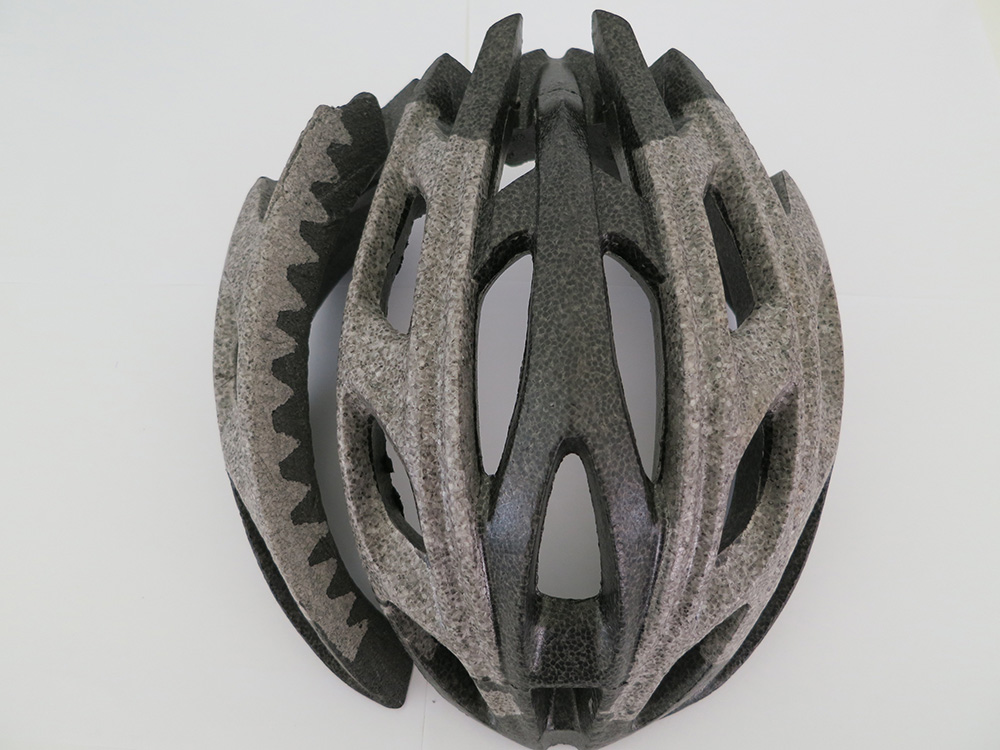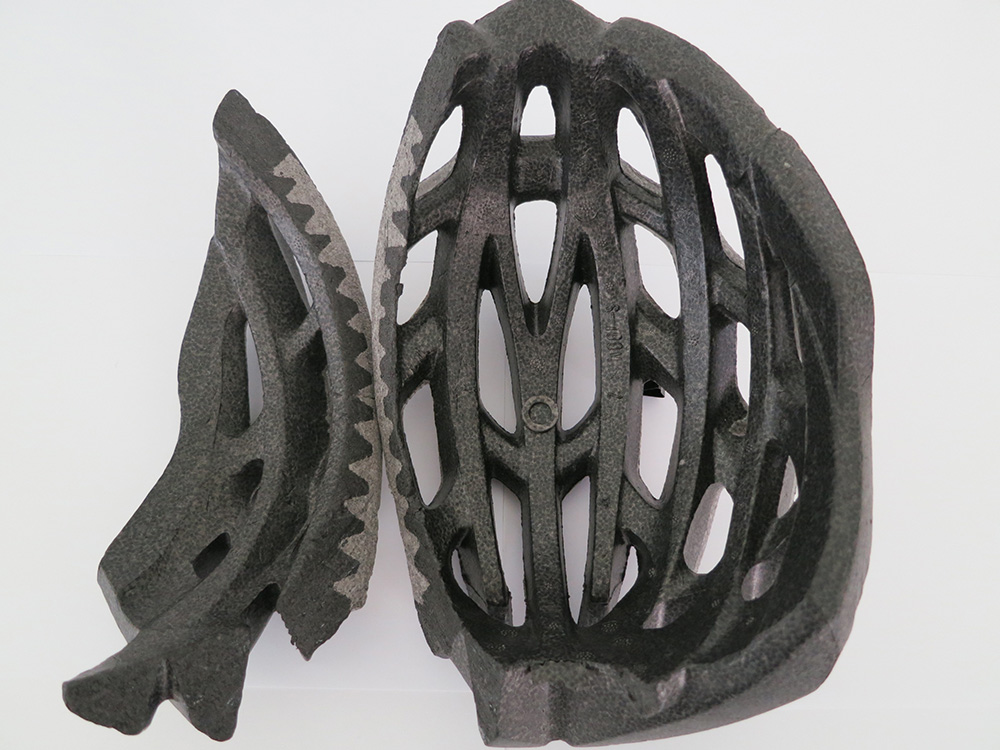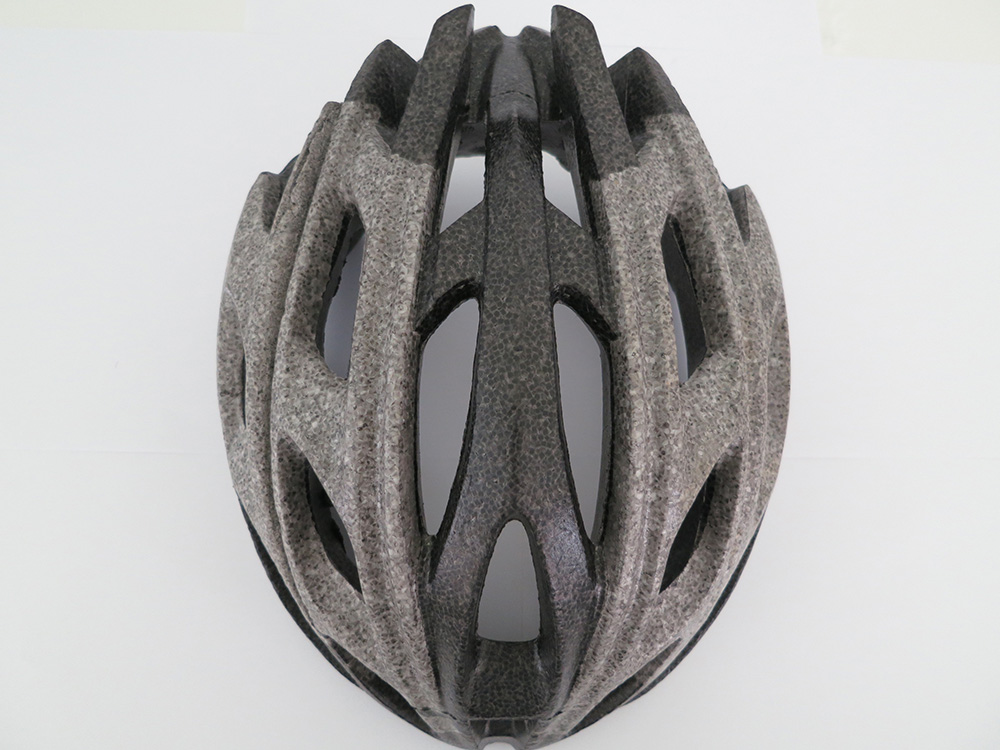 The bicycle helmet foam liner is made of two density layers. The outer layer, which is the black part, is made of high density foam and has cones facing inwards. The inner layer, the grey part which is close to the head, is made of softer low density foam and has cones facing outwards,
The bicycle helmet foam liner is made of two density layers. The outer layer, which is the black part, is made of high density foam and has cones facing inwards. The inner layer, the grey part which is close to the head, is made of softer low density foam and has cones facing outwards,
In the above diagram compression refers to when the cross-section of the foam liner is subjected to an impact force. The impact force, as indicated by the downward arrow, is pushing towards the head and causes the outer layer to compress. As a result, the impact energy spread outwards which in turn causes the tops of the lower density cones (the grey cones) to compress. The collapsing of the cones causes the energy to spread sideways within the thickness of the foam liner instead of towards the head. The dispersion of the energy sideways prevents the impact energy to be translated through to the brain
At the same time, the head is travelling in the opposite direction, as indicated by the arrow pointing upwards. You may recall this is Newton’s third law of motion – equal and opposite forces. As a result, the head causes the tops of the cones (the black cones) of the outer layer of high density foam to compress and therefore, once again, the energy is spread sideways. So the aim is to spread the energy sideways away from the head and brain.
Also, the fact that the head is continually pushing into higher density foam allows the head to gradually slow down or other words gradually decelerate. The result is a lower g-force to your head.
The true benefits of the new bicycle helmets incorporating the ![]() technology are:
technology are:
- a softer liner whereby the cones play a very important part to help to manage or absorb an impact force more efficiently
- a lighter helmet that helps to reduce rotational acceleration of the head during impact, and
- a softer liner close to one’s head to lower g-forces
The following three photos show a ![]() technology bicycle foam liner.
technology bicycle foam liner.
Photo 1:
Photo 1 shows the top view of a ![]() technology bicycle foam liner without outer shell. The grey area indicates where the cones are located in the liner.
technology bicycle foam liner without outer shell. The grey area indicates where the cones are located in the liner.
Photo 2:

Photo 2 shows the top view of the same ![]() technology bicycle liner, with the right side section cut away from the rest of the foam liner, revealing the cross-section of the right side comprising the inner black
technology bicycle liner, with the right side section cut away from the rest of the foam liner, revealing the cross-section of the right side comprising the inner black ![]() foam layer of low density and the outer grey foam layer of high density.
foam layer of low density and the outer grey foam layer of high density.
Please Note: the colour of the inner ![]() foam layer of low density and the outer foam layer of high density are the opposite of the diagram shown above ‘
foam layer of low density and the outer foam layer of high density are the opposite of the diagram shown above ‘![]() technology in action’.
technology in action’.
Photo 3:

Photo 3 shows the inside view of the same ![]() technology bicycle liner, with the right side cut away from the rest of the foam liner, revealing both cross-sections of the foam liner comprising of the inner black
technology bicycle liner, with the right side cut away from the rest of the foam liner, revealing both cross-sections of the foam liner comprising of the inner black ![]() foam layer of low density and the outer grey foam layer of high density.
foam layer of low density and the outer grey foam layer of high density.
‘Wearing a helmet is better than wearing no helmet.’
~ Don Morgan

